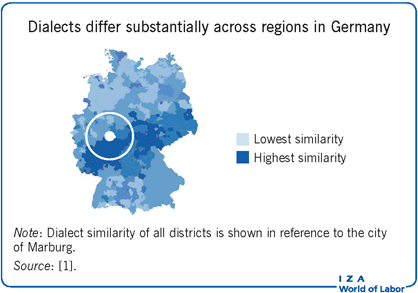Elevator pitch
Countries are not perfectly integrated market areas. Even if institutional differences are much smaller within than between countries, there are persistent local cultural differences. These differences act as barriers that reduce economic exchange: bilateral migration, trade, and knowledge diffusion flows are smaller, and individuals discriminate against unfamiliar dialects. They also act as natural limits to the degree of integration of a labor market, and they cannot (and perhaps should not) be easily affected by policy. Local dialects, shaped over centuries, provide a unique opportunity to measure these barriers.
Key findings
Pros
Speech patterns have been shaped over centuries.
Dialects provide a rich portrayal of local cultural diversity and history.
Dialect similarity fosters migration, trade, and knowledge flows, and people prefer to reside in and interact with people from linguistically familiar environments.
Dialects, as measured by linguistic microdata, provide a unique opportunity to measure the effects of cultural differences on internal migration and economic outcomes.
Linguistic differences slowly erode, but not the underlying cultural barriers; these remain visible in dialect differences, which are no longer actual communication barriers.
Cons
Cultural barriers (measured via differences in dialect) reduce economic exchange across regions.
Cultural barriers limit the possibility for perfectly integrated national labor markets.
It is not clear if policymakers should aim for a reduction of cultural barriers, nor is it clear that they have any instruments to do so.
Dialect data are scarce and high-quality data are available only for a few countries.
